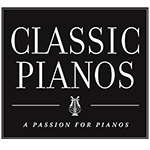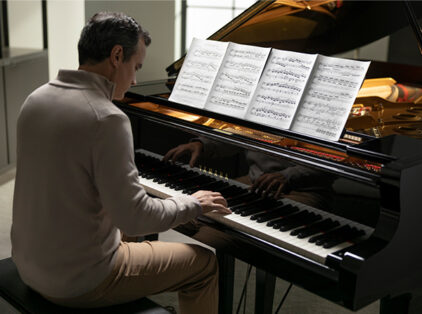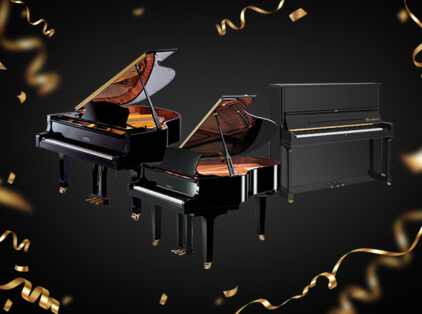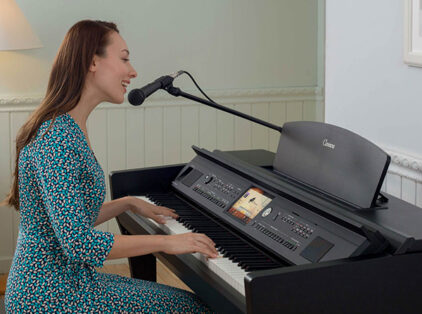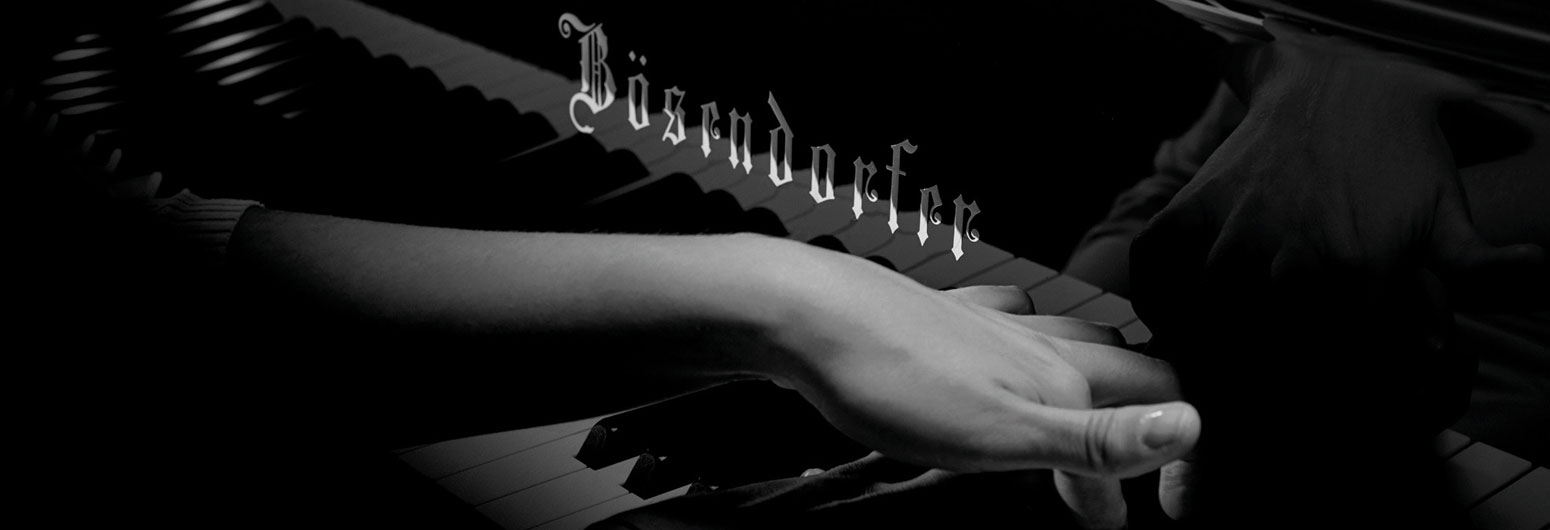
Five major benefits of owning and playing a well-made grand piano
Are you trying to decide between the purchase of a grand piano and an upright piano? Let us help you make that decision easier! In this blog post, we’ll give you five reasons why playing a grand piano is often better than its smaller counterpart.
It’s important to remember that in this article, we’re comparing a well-designed, high-quality grand piano to a standard upright (also known as a vertical piano). In some cases, a well-made, beautifully designed upright is preferable over a cheaply made grand. It’s vital that we highlight this distinction. That said, assuming the quality between the two is equal, most musicians, artists, and educators commonly agree that a grand piano is preferable when budget and space allow.
From the incredible sound quality to the responsive feel of the keys, we want to outline the benefit, joy, and inspiration that playing on a high-quality grand piano provides.
So, sit back, relax, and explore the benefits of a grand piano over an upright when it comes to sound, touch, pedals, appearance, and value:
1. Grand pianos generally feature a richer sound than upright pianos
Because of their longer strings, larger hammers, and a bigger soundboard amplifying the strings’ sound, grand pianos have a fuller, richer, and more resonant sound than most upright pianos.
And here’s a surprise: Grand pianos allow the player to play both softer and louder with more expression. On a grand piano, you’ll have a wider range of dynamics from very soft (ppp) to very loud (fff). Plus, the ability of a grand to create warm, rich colors provides the player with an instrument on which to play their best, be inspired, and reach their full potential.
2. Grand pianos have a more natural and responsive touch
When it comes to piano playing, the feel of the keys is often as important as the sound. And when it comes to grand pianos vs upright pianos, there are some big differences in the feel of the keys:
- Although they look the same from the playing area, Grand pianos typically have longer keys than an upright, allowing for greater control over the touch and tone of the piano.
- Grand piano actions (the mechanism of the piano that causes hammers to strike the strings when a key is pressed) use gravity to return the keys to their resting position, providing a more natural and responsive feel than upright pianos that rely on springs to reset the keys.
- A grand piano’s action is usually quicker and more responsive than those on a vertical piano. This is due to the “repetition lever” — an ingenious design that lets a pianist repeat a note with much less effort than an upright.
In short, the responsive touch of a grand piano — combined with its sound-producing aspect — allows a player to have greater control of the dynamic range and to play with more responsiveness, expression, and color.
3. A grand piano’s pedals support a wider range of sounds and effects
When comparing upright and grand pianos, one of the most important features is the distinct differences in their pedals — foot-operated levers, accessible at the front base of a piano, which change the instrument’s sound in various ways.
The “una corda” pedal
The left pedal on a grand piano is called the “una corda pedal” (also known as the “soft pedal” or “shift pedal”), and it shifts the piano keys and action into a position that causes the hammers to strike the strings differently to make the sound of the notes softer.
This pedal is often used when playing delicate passages or creating a gentle, quiet sound, allowing the player to reach levels of beauty and intimacy with wonderful results.
On an upright piano, the left pedal is known as the “shift” pedal because it positions the hammers closer to the strings. This movement softens the volume of a piano but does not affect the tone of its sound as much.
The “sostenuto” pedal
A grand piano’s middle pedal, called the “sostenuto pedal,” holds the tone of certain notes while other notes are played by raising dampers to keep them away from the strings. This can be helpful for creating interesting sound effects or for sustaining particular notes in a passage.
By comparison, the middle pedal on many modern upright pianos is known as a muffler. It works by adding a thin piece of felt between an instrument’s hammers and strings to mute the sound.
The “damper” pedal
The right pedal on both grand and upright pianos, known as the “damper” pedal, is the most commonly used. Its purpose is to pull the dampers from the strings and hold the sound of notes being played, allowing a pianist to play sustained chords or single notes that ring out for a longer period.
While the pedals on an upright do offer some control of the sound of an instrument, the pedals on a grand allow for greater playing expression.
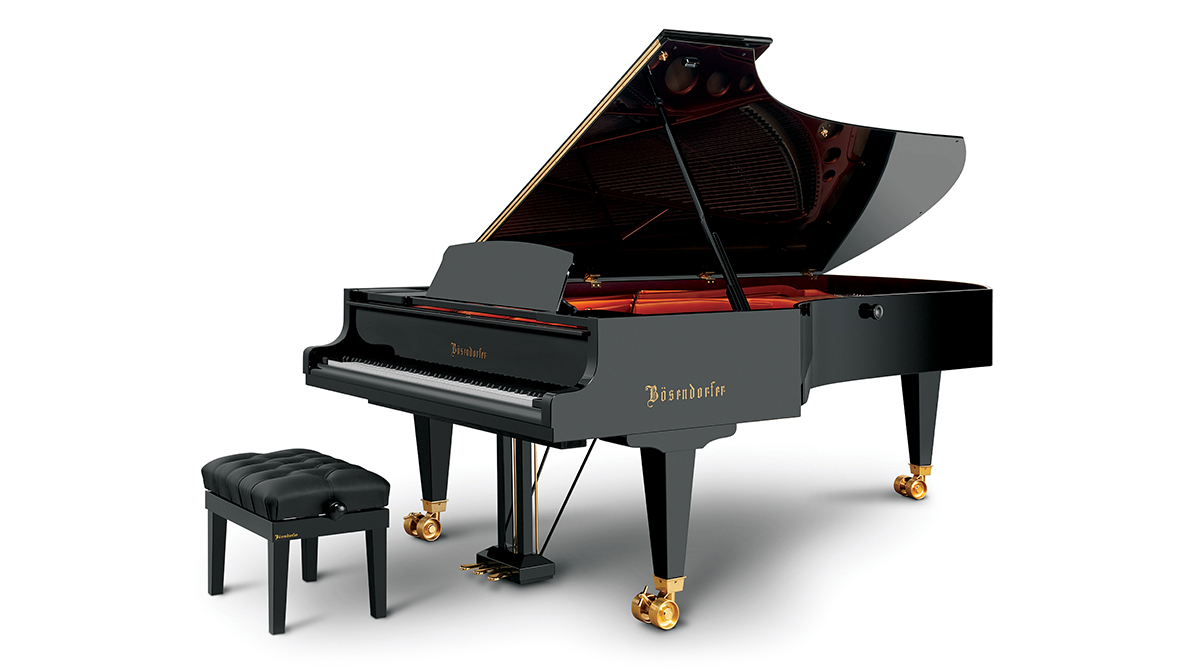
4. The appearance of a grand piano commands attention
Grand pianos are a true masterpiece of design, engineering, and musical achievement — and their shape is iconic. While they’re all generally the same width (around five feet), they are available in a wide range of lengths. Baby grands are generally classified as being up to 5’7” in length, while full grands are measured between 5’10 – 7’ in length. The honor of the concert grand title (for instruments like the Bösendorfer 290, which is 9’6” in length), are reserved for pianos that are greater than 9’ in length.
Whether it’s the sheer size of the instrument, the intricate details of its construction or simply the timeless beauty it exudes, there’s no denying that a grand piano is a magnificent piece of artistry.
5. Grand pianos can hold their value better
While it’s true that a grand piano generally costs more than an upright piano, grands tend to hold their value better over time if they are well-maintained. This is not true in every situation, but serious musicians and collectors will often pay more for a high-quality used grand than a used upright.
Some makers tout the “investment value” of their pianos. While it’s true the retail price of pianos increase over time, this benefit is misleading. The fact is that most pianos depreciate in value over time. with some well-made quality brands depreciating slower than others. The true investment in a piano is in its ability to bring joy and happiness to the owner. If one is able to sell their piano privately years after purchase for more or for what they originally paid, that is a fortunate bonus.
Is an upright piano ever a better choice than a grand piano?
Most experts agree that the benefits of sound, touch, appearance, and financial value often tip the scales to the grand piano when compared to an upright. Knowing this, you might wonder if there is ever a time when the upright reigns supreme.
The answer? There are exceptions. A high-quality new (or newer) upright piano will generally outperform an older, poorly maintained, or low-quality used grand piano. Again, the brand of the piano and how it has been maintained contribute to its current playability.
If space is a consideration, the choice may be made for you. Leading piano dealers will happily assess your space to determine whether and where a grand piano could best be positioned, but it’s hard to make space where there is none. For some families, an excellent quality upright piano is the best choice for their home, if for no other reason than the measurements of their room.
Compare grand pianos and upright pianos for yourself to understand their differences
It’s important to note that grand and upright pianos have unique advantages and limitations. There are no “right or wrong” answers in your decision to bring a piano into your home! Ultimately, it is up to each individual or family to decide which type best suits their needs based on personal preferences, budget, and space constraints.
The best way to determine whether a new or used grand or upright piano will work best for your needs is to play as many as possible! In your search for a piano you love, you may find that a quality upright fits your needs and your budget. Or, you could discover that a grand piano is worth the additional investment (especially if financing is available to ease the decision).
Take advantage of expert help!
We encourage you to visit our showroom to enjoy a low-pressure opportunity to play a wide variety of new and used grand and upright pianos, side-by-side, to discover the right instrument for your needs and your budget.
Call 503-239-9969 or visit our showroom to see our vast inventory. Our position as America’s most awarded piano dealership grants us access to exceptional inventory at very competitive prices.
Buy with confidence, thanks to our legendary Five-Star Trade-Up policy, which guarantees that the value of your acoustic piano purchase will never depreciate.
